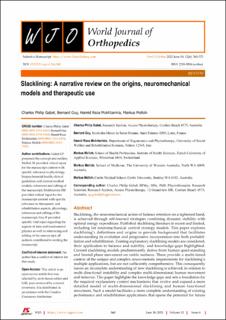Please use this identifier to cite or link to this item:
https://doi.org/10.21256/zhaw-25890| Publication type: | Article in scientific journal |
| Type of review: | Peer review (publication) |
| Title: | Slacklining : a narrative review on the origins, neuromechanical models and therapeutic use |
| Authors: | Gabel, Charles Philip Guy, Bernard Mokhtarinia, Hamid Reza Melloh, Markus |
| et. al: | No |
| DOI: | 10.5312/wjo.v12.i6.360 10.21256/zhaw-25890 |
| Published in: | World Journal of Orthopedics |
| Volume(Issue): | 12 |
| Issue: | 6 |
| Page(s): | 360 |
| Pages to: | 375 |
| Issue Date: | 2021 |
| Publisher / Ed. Institution: | Beijing Baishideng BioMed Scientific |
| ISSN: | 2218-5836 |
| Language: | English |
| Subjects: | Balance; Human movement; Model; Neuromechanics; Rehabilitation; Slacklining |
| Subject (DDC): | 615: Pharmacology and therapeutics |
| Abstract: | Slacklining, the neuromechanical action of balance retention on a tightened band, is achieved through self-learned strategies combining dynamic stability with optimal energy expenditure. Published slacklining literature is recent and limited, including for neuromechanical control strategy models. This paper explores slacklining's definitions and origins to provide background that facilitates understanding its evolution and progressive incorporation into both prehabilitation and rehabilitation. Existing explanatory slacklining models are considered, their application to balance and stability, and knowledge-gaps highlighted. Current slacklining models predominantly derive from human quiet-standing and frontal plane movement on stable surfaces. These provide a multi-tiered context of the unique and complex neuro-motoric requirements for slacklining's multiple applications, but are not sufficiently comprehensive. This consequently leaves an incomplete understanding of how slacklining is achieved, in relation to multi-directional instability and complex multi-dimensional human movement and behavior. This paper highlights the knowledge-gaps and sets a foundation for the required explanatory control mechanisms that evolve and expand a more detailed model of multi-dimensional slacklining and human functional movement. Such a model facilitates a more complete understanding of existing performance and rehabilitation applications that opens the potential for future applications into broader areas of movement in diverse fields including prostheses, automation and machine-learning related to movement phenotypes. |
| URI: | https://digitalcollection.zhaw.ch/handle/11475/25890 |
| Fulltext version: | Published version |
| License (according to publishing contract): | CC BY-NC 4.0: Attribution - Non commercial 4.0 International |
| Departement: | School of Health Sciences |
| Organisational Unit: | Institute of Public Health (IPH) |
| Appears in collections: | Publikationen Gesundheit |
Files in This Item:
| File | Description | Size | Format | |
|---|---|---|---|---|
| 2021_Gabel-etal_Slacklining-narrative-review-origins-neuromechanical-models-therapeutic-use.pdf | 762.02 kB | Adobe PDF |  View/Open |
Show full item record
Gabel, C. P., Guy, B., Mokhtarinia, H. R., & Melloh, M. (2021). Slacklining : a narrative review on the origins, neuromechanical models and therapeutic use. World Journal of Orthopedics, 12(6), 360–375. https://doi.org/10.5312/wjo.v12.i6.360
Gabel, C.P. et al. (2021) ‘Slacklining : a narrative review on the origins, neuromechanical models and therapeutic use’, World Journal of Orthopedics, 12(6), pp. 360–375. Available at: https://doi.org/10.5312/wjo.v12.i6.360.
C. P. Gabel, B. Guy, H. R. Mokhtarinia, and M. Melloh, “Slacklining : a narrative review on the origins, neuromechanical models and therapeutic use,” World Journal of Orthopedics, vol. 12, no. 6, pp. 360–375, 2021, doi: 10.5312/wjo.v12.i6.360.
GABEL, Charles Philip, Bernard GUY, Hamid Reza MOKHTARINIA und Markus MELLOH, 2021. Slacklining : a narrative review on the origins, neuromechanical models and therapeutic use. World Journal of Orthopedics. 2021. Bd. 12, Nr. 6, S. 360–375. DOI 10.5312/wjo.v12.i6.360
Gabel, Charles Philip, Bernard Guy, Hamid Reza Mokhtarinia, and Markus Melloh. 2021. “Slacklining : A Narrative Review on the Origins, Neuromechanical Models and Therapeutic Use.” World Journal of Orthopedics 12 (6): 360–75. https://doi.org/10.5312/wjo.v12.i6.360.
Gabel, Charles Philip, et al. “Slacklining : A Narrative Review on the Origins, Neuromechanical Models and Therapeutic Use.” World Journal of Orthopedics, vol. 12, no. 6, 2021, pp. 360–75, https://doi.org/10.5312/wjo.v12.i6.360.
Items in DSpace are protected by copyright, with all rights reserved, unless otherwise indicated.